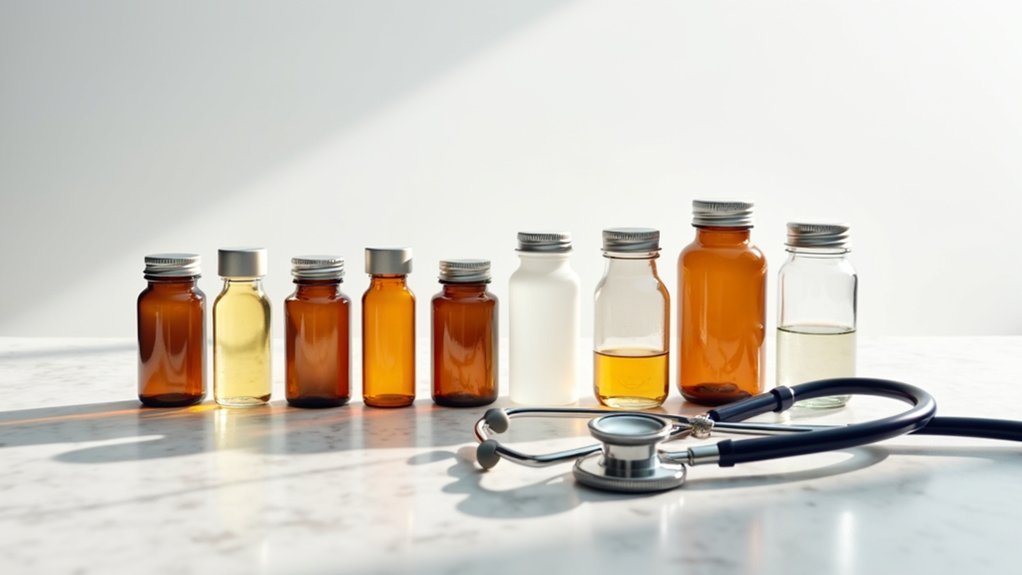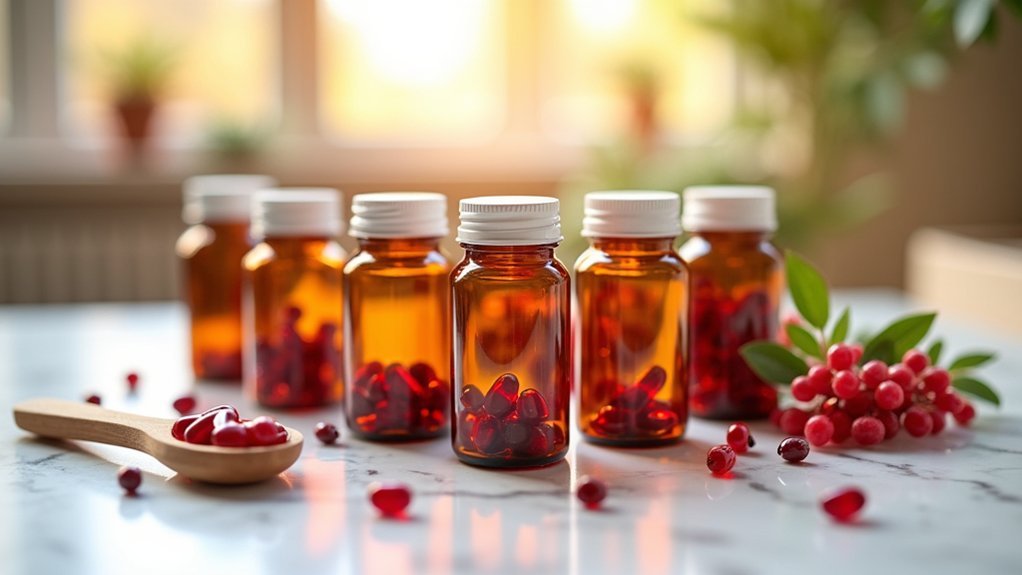You’ll benefit from cranberry’s powerful A-type proanthocyanidins that block harmful bacteria like E. coli from adhering to your urinary tract cells by up to 75%. These bioactive compounds strengthen your cellular barriers, reduce oxidative stress more effectively than vitamins C and E, and lower UTI recurrence rates by 26-54% in high-risk populations. Cranberry’s antioxidants protect cellular membranes, enhance epithelial cell regeneration, and provide antibiotic-free defense that begins working within two hours of consumption while supporting long-term urinary health through enhanced barrier function and reduced bacterial colonization.
Proanthocyanidins Block Bacterial Adhesion to Urinary Tract Cells

When harmful bacteria enter your urinary tract, cranberry’s proanthocyanidins act as molecular bouncers that prevent these invaders from sticking to your urinary tract cells.
These powerful compounds specifically target P-fimbriated bacteria like E. coli and Proteus mirabilis, which use tiny appendages called fimbriae to attach and colonize your urinary system.
A2-type proanthocyanidins found in cranberries reduce bacterial adhesion by up to 75% without killing the bacteria—they simply block attachment. This prevention strategy stops infections before they start by disrupting the initial colonization process.
Beyond blocking adhesion, these compounds reduce bacterial motility and interfere with quorum sensing, preventing coordinated bacterial behavior.
The effectiveness depends on concentration and bioavailability, with soluble formulations showing superior antiadhesion activity in your urinary tract. Research shows that juice extract products demonstrate higher soluble PAC levels and greater urinary anti-adhesion activity compared to whole cranberry preparations.
Natural Defense Against E. Coli Infection Without Antibiotics
Building on this adhesion-blocking mechanism, cranberry’s organic acids take your urinary tract defense a step further by directly reducing E. coli colonization without requiring antibiotics.
Research shows cranberry juice markedly decreases bacterial counts in bladder tissue, with malic acid combinations proving most effective when paired with citric or quinic acid.
You’ll benefit from cranberry’s multi-layered approach that begins working within two hours of consumption and continues protecting for up to ten hours.
The organic acids don’t just prevent bacterial attachment—they actively reduce existing E. coli populations while simultaneously decreasing inflammation in your urinary tissues.
This natural defense strategy offers you a non-pharmaceutical option that complements your body’s immune system, though it shouldn’t replace medical treatment for serious infections. Studies demonstrate that cranberry juice reduces urinary pH from 6.5 to 5.8, creating an environment that enhances your body’s natural ability to clear infections.
Cellular Protection Through Antioxidant Compound Activity

Your urinary tract cells face constant threats from free radicals and oxidative stress that can compromise their protective barriers.
Cranberry’s proanthocyanidins act as powerful antioxidants, actively neutralizing these harmful molecules before they can damage your cellular membranes.
This antioxidant action creates a robust defense system that helps maintain the structural integrity of your urinary tract’s cellular walls. These compounds also provide anti-inflammatory effects that reduce inflammation associated with urinary tract infections, further protecting your cellular health.
Proanthocyanidin Antioxidant Action
Cranberries stand out among fruits for their exceptional concentration of proanthocyanidins, powerful antioxidant compounds that provide robust cellular protection for your urinary tract.
These bioactive molecules scavenge harmful reactive oxygen species, preventing oxidative damage to your urinary cells more effectively than vitamins C and E in comparative studies.
You’ll benefit from proanthocyanidins’ ability to modulate cellular proteins, increasing protective Bcl-2 while decreasing harmful Bax and caspase-3.
They preserve your mitochondrial integrity under oxidative stress and activate the Nrf2/HO-1 protective pathways.
This antioxidant action reduces urinary tract inflammation, maintains epithelial barrier function, and helps prevent infection initiation.
Working synergistically with other cranberry polyphenols like anthocyanins, proanthocyanidins amplify your cellular defense mechanisms against oxidative injury.
The compounds also bind divalent cations like iron and copper in your urinary system, indirectly reducing oxidative activity that could damage cellular structures.
Free Radical Neutralization
While proanthocyanidins provide the foundation for cranberry’s antioxidant prowess, the fruit’s complete arsenal of polyphenolic compounds creates a thorough defense network that actively neutralizes free radicals throughout your urinary system.
These antioxidant molecules scavenge harmful reactive oxygen species (ROS) that would otherwise damage your cellular structures and trigger inflammatory responses.
Cranberry’s flavonoids, including anthocyanins, quercetin, and myricetin, work synergistically to reduce oxidative stress by directly neutralizing free radicals before they can harm your cells.
This neutralization process prevents mitochondrial damage and supports peak cellular function within your urinary tract. Research indicates that 364 mg/day of polyphenols effectively reduces oxidative stress markers in the body.
Cellular Membrane Defense
Beyond neutralizing free radicals, cranberry’s antioxidant compounds create a protective barrier that actively defends your cellular membranes from oxidative damage.
Cranberry’s unique A-type proanthocyanidins (PACs) make up over 94% of its polyphenolic content, offering superior membrane protection compared to other fruits. These compounds directly interact with your cell membranes, preventing lipid peroxidation and maintaining membrane integrity. Research demonstrates that cranberry proanthocyanidins exhibit dose-dependent effects on cellular structures, influencing how cells interact with their environment.
You’ll benefit from preserved cellular communication and homeostasis as cranberry polyphenols stabilize membrane fluidity and function. Additionally, these protective compounds cross membrane barriers to provide intracellular defense while modulating enzyme activity related to oxidative stress pathways.
- Your cells stay stronger against daily oxidative assault
- Membrane integrity remains intact during stressful periods
- Cellular communication flows smoothly without disruption
- Your body’s natural defense systems work more effectively
- Long-term cellular health gets sustained protection
Reduced UTI Recurrence Rates in Susceptible Populations

Although urinary tract infections affect millions of people annually, certain populations face dramatically higher recurrence rates that can greatly impact their quality of life. If you’re part of a high-risk group, cranberry products can markedly reduce your UTI recurrence.
| Population | Risk Reduction | Definition |
|---|---|---|
| Children | 54% | Pediatric patients with recurrent infections |
| Post-procedure patients | 53% | Those undergoing bladder radiotherapy or urinary procedures |
| Women with recurrent UTIs | 26% | Two or more UTIs in six months |
| General women | 26% | Statistically significant protection |
| High-risk adults | Variable | Those vulnerable after medical interventions |
You’ll see the most dramatic benefits if you’re dealing with recurrent infections, defined as three or more UTIs within a year. Clinical evidence from over 8,800 participants confirms these protective effects. A recent meta-analysis published in JAMA reinforces the significant effectiveness of cranberry products in reducing urinary tract infection risk across diverse patient populations.
Enhanced Urinary Tract Barrier Function and Cell Integrity
Your urinary tract’s protective barriers work as your first line of defense against harmful bacteria, and cranberry’s proanthocyanidins actively strengthen these cellular walls at the molecular level.
These powerful compounds don’t just prevent bacterial adhesion to your epithelial cells—they actually enhance the integrity of tight junction proteins that seal gaps between cells.
When you consume cranberry regularly, you’re reinforcing your urinary tract’s natural barrier system, making it considerably harder for pathogens to establish infection in the first place. Cranberry-derived phenolic metabolites like DOPAC and PAA provide protective effects specifically to your urothelial cells, which form the specialized lining of your urinary tract.
Bacterial Adhesion Prevention
When harmful bacteria attempt to establish infections in your urinary tract, cranberry’s A-type proanthocyanidins (PACs) act as molecular guardians that specifically target and disrupt this critical first step.
These powerful compounds bind directly to P-fimbriae on E. coli bacteria, altering their surface structure and preventing attachment to your bladder and vaginal epithelial cells. This anti-adhesion mechanism reduces bacterial colonization and biofilm formation while preserving your epithelial barrier integrity.
You’ll need at least 36 mg of PACs daily to achieve clinically relevant protection against UTIs. However, current research shows inconsistent patient-oriented evidence regarding the overall effectiveness of cranberry products for preventing urinary tract infections.
- Shield your cells from bacterial invasion and tissue damage
- Prevent colonization before infections can take hold
- Maintain barrier strength against recurrent UTI episodes
- Reduce inflammation and cellular stress naturally
- Protect deep tissues from bacterial penetration
Cellular Wall Protection
Cranberry’s protective benefits extend far beyond preventing bacterial adhesion to encompass extensive strengthening of your urinary tract’s cellular defenses. The polyphenols and flavonoids in cranberries stabilize your cell membranes while reducing oxidative stress that damages urothelial cells. These compounds enhance tight junction proteins like occludin and claudin, creating stronger seals between cells that prevent bacterial invasion through paracellular pathways.
| Cranberry Component | Cellular Protection Benefit |
|---|---|
| Polyphenols | Stabilize membranes, reduce oxidative stress |
| Flavonoids | Strengthen tight junctions, prevent leakage |
| Phenolic acids | Maintain barrier proteins, support regeneration |
| Antioxidants | Minimize cell damage, enhance repair signals |
Your epithelial cells regenerate faster and resist environmental stress more effectively when supported by cranberry’s bioactive compounds, maintaining a robust urinary barrier. This cellular protection is particularly valuable since biofilm formation by uropathogens can significantly enhance their resistance to antimicrobial treatments.
Proanthocyanidin Barrier Support
While cranberry’s cellular protection mechanisms work broadly across your urinary tract, proanthocyanidins (PACs) deliver targeted barrier reinforcement that’s measurably more powerful than other polyphenolic compounds.
These specialized molecules work synergistically to strengthen your epithelial barriers, modulating tight junction proteins that maintain cellular integrity. When you consume cranberry PACs, their phenolic metabolites enhance barrier function most effectively in healthy tissue, reducing permeability to harmful solutes and bacterial infiltration. A-type proanthocyanidins demonstrate superior bioactivity compared to their B-type counterparts, providing enhanced cellular defense capabilities.
- Shield your cells from bacterial invasion through reinforced epithelial barriers
- Maintain structural integrity of your urinary tract’s protective cellular walls
- Reduce vulnerability to pathogenic infiltration and tissue damage
- Support natural healing processes when your barriers face bacterial assault
- Preserve long-term urinary tract health through sustained cellular protection
Prevention of Cellular Damage From Recurring Infections
Although urinary tract infections might seem like minor inconveniences, recurring episodes can cause significant cellular damage that accumulates over time. Each infection triggers inflammation and oxidative stress that damages your urinary tract’s delicate cellular structure.
When bacteria like E. coli repeatedly attach to your uroepithelial cells, they create biofilms and chronic inflammation that injures healthy tissue.
Cranberry’s A-type proanthocyanidins prevent this cascade by blocking bacterial adhesion before damage occurs. You’ll experience fewer symptomatic UTIs when you consume cranberry regularly, particularly if you’re prone to recurrent infections.
Clinical studies show cranberry supplementation reduces infection frequency, which directly correlates with less cumulative cellular damage. This protection helps preserve your urinary tract’s cellular integrity and prevents the scarring and dysfunction associated with chronic infections. The recommended cranberry extract dosage is 300-400 mg twice daily for optimal protective benefits.
Non-Pharmaceutical Support for Post-Surgical Urinary Health
After surgery, you’ll want to protect your urinary tract from infections without relying solely on antibiotics.
Your body needs gentle, natural support to heal properly while maintaining healthy urinary function. During your hospital stay, proper urinary health becomes even more critical as your body adapts to changes.
Cranberry’s antimicrobial properties can help prevent post-surgical UTIs and support your recovery through this vulnerable period.
Post-Surgical UTI Prevention
When you undergo gynecological surgery requiring catheter placement, your UTI risk jumps considerably to anywhere from 10% to 64% after catheter removal.
However, cranberry capsules can considerably reduce your chances of developing a post-surgical UTI. In a rigorous double-blind trial, women taking cranberry capsules experienced only 19% UTI rates compared to 38% in the placebo group. Research from pelvic floor surgery patients shows that cranberry supplementation can provide protective benefits during the vulnerable post-operative period.
The capsules work by delivering concentrated proanthocyanidins that prevent harmful bacteria from adhering to your urinary tract cells. You’ll take the equivalent of two 8-ounce servings of cranberry juice twice daily for six weeks post-surgery, providing consistent protection without drug interactions.
- Cut your UTI risk in half when you’re most vulnerable after surgery
- Avoid unnecessary antibiotic treatments that can disrupt your healing process
- Protect yourself naturally without worrying about pharmaceutical side effects
- Take control of your recovery with evidence-based prevention strategies
- Experience peace of mind knowing you’re actively preventing painful infections
Antibiotic-Free Recovery Support
While antibiotics remain the standard treatment for established UTIs, your post-surgical recovery doesn’t have to depend solely on pharmaceutical interventions. Cranberry supplements offer a compelling non-pharmaceutical approach that supports your urinary health naturally.
| Antibiotic Approach | Cranberry Approach |
|---|---|
| Risk of resistance development | No resistance concerns |
| Potential side effects | Natural, minimal side effects |
| Higher long-term costs | Cost-effective prevention |
| Disrupts beneficial bacteria | Maintains microbial balance |
| Requires prescription | Available over-the-counter |
You’ll benefit from cranberry’s proanthocyanidins (PACs), which prevent E. coli from adhering to your bladder walls. This mechanism reduces your UTI risk by approximately 50% in clinical studies. By choosing concentrated cranberry capsules over juice, you’re getting maximum PAC content for ideal protection during your vulnerable recovery period.
For those experiencing recurring UTIs, cranberry supplementation provides a particularly valuable preventive strategy, as 20-30% of women face this challenging pattern of repeated infections.
Strengthened Cellular Resistance to Uropathogenic Bacteria
Beyond cranberry’s ability to acidify urine and provide antioxidant protection, these ruby-red berries strengthen your body’s cellular defenses against harmful bacteria through sophisticated molecular mechanisms.
Cranberry’s proanthocyanidins act as molecular decoys, binding to bacterial fimbriae before they can attach to your urinary tract cells. This competitive binding fundamentally tricks bacteria into grabbing onto cranberry compounds instead of your tissue.
Cranberry compounds cleverly hijack bacterial attachment mechanisms, creating molecular interference that prevents harmful microbes from anchoring to your urinary tract walls.
Additionally, cranberry disrupts bacterial communication and persistence mechanisms that would otherwise allow infections to establish deep roots in your system. Cranberry constituents also prevent harmful bacteria from adopting filamentous morphotypes that help them resist immune system clearance and establish chronic infections. Just 240 mL of cranberry juice can block 80% of harmful E. coli from adhering to your urothelium for up to 10 hours.
- Your cells become slippery fortresses where bacteria simply can’t gain a foothold
- Bacterial invaders lose their grip and get flushed away before causing damage
- Your natural defenses work smarter, not harder with cranberry’s molecular assistance
- Recurrent infections become less likely as persistence mechanisms fail
- Protection lasts for hours with each serving of cranberry
Bioactive Compounds Preserve Urinary Epithelial Cell Health
Cranberry’s protective mechanisms extend far deeper than surface-level bacterial blocking—these bioactive compounds actually fortify and heal your urinary tract’s cellular foundation.
When you consume cranberry products, polyphenols and phenolic acids directly shield your urothelial cells from bacterial damage while strengthening barrier integrity. The xyloglucan oligosaccharides specifically target your bladder epithelial cells, creating a protective shield against E. coli attachment.
Meanwhile, cranberry metabolites like valerolactones work at the cellular level to prevent injury and maintain healthy cell function. These bioactives don’t just fight infection—they’re actively preserving your urinary epithelial cell health, ensuring your bladder and urethral walls remain resilient against future bacterial invasions while supporting overall urinary tract wellness.
The A-type linkages in cranberry proanthocyanidins are specifically responsible for the antiadhesion activity that prevents bacterial attachment to uroepithelial cells.
Long-Term Cellular Benefits Through Regular Cranberry Consumption
When you commit to regular cranberry consumption over 12 to 24 weeks, you’re investing in profound cellular transformations that extend far beyond immediate bacterial protection.
Your urinary tract cells undergo remarkable changes as proanthocyanidins continuously shield them from harmful E. coli adhesion. This sustained protection allows your cellular defenses to strengthen naturally, creating a fortress-like barrier against recurrent infections.
The metabolic pathways within your cells adapt through enhanced tryptophan and cobalamin transport mechanisms. You’ll experience reduced inflammation as your body prevents bacterial colonization before it starts. Quality cranberry supplements vary significantly in their PAC concentrations, making it essential to choose products with verified potency for optimal cellular benefits.
These antioxidant compounds work tirelessly to repair cellular damage while maintaining ideal urinary epithelial function.
- Your cells develop stronger natural defenses against bacterial invasion
- Inflammation decreases as infections become increasingly rare
- Cellular repair accelerates through powerful antioxidant protection
- Your urinary tract transforms into an inhospitable environment for harmful bacteria
- Freedom from antibiotic dependency becomes your new reality
Frequently Asked Questions
What Is the Optimal Daily Dosage of Cranberry Supplements for Urinary Health?
You should take 500-1,500 mg of dried cranberry powder daily or cranberry extract with 36 mg proanthocyanidins. Alternatively, you can drink 240-300 ml cranberry juice cocktail for ideal urinary health benefits.
Can Cranberry Juice Be as Effective as Cranberry Capsules for Prevention?
You’ll find cranberry juice less effective than capsules for UTI prevention. Juice loses active ingredients before reaching your bladder, while capsules provide consistent dosing and better bioavailability of protective compounds.
How Long Does It Take to See Results From Cranberry Consumption?
You’ll likely see cranberry’s preventive effects within 4 weeks of regular consumption, though some studies show benefits taking up to 12 months. Consistent daily intake works better than occasional use.
Are There Any Side Effects or Interactions With Medications to Consider?
You’ll generally tolerate cranberry well, but high doses can cause diarrhea and stomach upset. It may increase bleeding risk with warfarin, so consult your healthcare provider before combining cranberry with blood-thinning medications.
Should Cranberry Products Be Standardized for Proanthocyanidin Content to Ensure Effectiveness?
Yes, you’ll benefit from standardized cranberry products with specified PAC content. Without standardization, you’re getting inconsistent doses that won’t reliably prevent UTIs or deliver the proven cellular protection benefits.
In Summary
You’ve now discovered how cranberries can transform your urinary health at the cellular level. You’re getting powerful proanthocyanidins that block harmful bacteria, antioxidants that protect your cells, and natural compounds that strengthen your urinary tract’s defenses. You don’t need pharmaceuticals when you’ve got cranberries working to reduce infections, support healing, and maintain long-term cellular integrity. Start incorporating cranberries into your routine today.





Leave a Reply